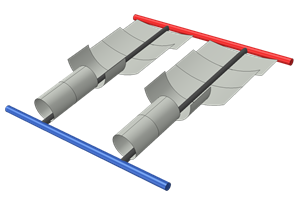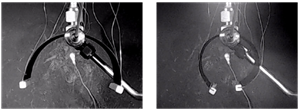A team of researchers led by Dr. Darren Hartl, assistant professor in the Department of Aerospace Engineering at Texas A&M University, has been selected for the second consecutive year by NASA’s Johnson Space Center (NASA JSC) to continue development of an advanced passively morphing radiator concept for manned spaceflight. Solutions such as shape adaptive radiators have been identified in the NASA Technology Roadmaps as essential to the success of future manned missions, such as proposed missions to Mars.
 Thermal control is necessary to provide the crew with suitable living and working conditions, as well as maintain specified temperatures for all of the equipment onboard the spacecraft. Thermal control in manned missions is particularly difficult due to the small range of acceptable cabin temperatures and the large variation in external conditions throughout a given mission.
Thermal control is necessary to provide the crew with suitable living and working conditions, as well as maintain specified temperatures for all of the equipment onboard the spacecraft. Thermal control in manned missions is particularly difficult due to the small range of acceptable cabin temperatures and the large variation in external conditions throughout a given mission.
A manned spacecraft in orbit will generate a much larger amount of heat than one in coast, for example, while on a trajectory to Mars. Excess heat created on the spacecraft is rejected into space via the use of radiators. A morphing radiator using shape memory alloys (SMAs) provides a lightweight way to adjust the heat rejection.
Hartl first began working with NASA JSC engineers in 2013 on novel concepts for self-morphing radiators based on the unique characteristics of SMAs. These materials are very strong and generate large motions as temperatures change. They enable the possibility of radiator panels that open widely to space when heated and curl up closed when cooled.
SMAs actuators operate using a phase transformation, so they can be made to shrink when heated, which is the opposite of conventional thermal expansion. The SMA is coupled with composite panels to make the radiator. Placed on the outside, the shrinking SMA causes the panels on the radiator to open and release heat to the atmosphere. When the environment is cooler, the SMA cools and expands, causing the radiator to close and retain heat. This process enables a fully passive thermal control system at a greatly reduced weight as compared to other options.
 As a student working under Hartl, Christopher Bertagne was granted a NASA Space Technology Research Fellowship (NSTRF) to focus on developing computational tools to better understand this concept. Bertagne has since graduated and joined the NASA/CalTech Jet Propulsion Lab (JPL) as a Thermal Engineer.
As a student working under Hartl, Christopher Bertagne was granted a NASA Space Technology Research Fellowship (NSTRF) to focus on developing computational tools to better understand this concept. Bertagne has since graduated and joined the NASA/CalTech Jet Propulsion Lab (JPL) as a Thermal Engineer.
“I believe the success we have had in designing, understanding and eventually proving the feasibility of this novel concept was critical to placing Chris in his dream job at JPL,” Hartl said.
Moving forward, Hartl will work with colleague John Whitcomb, professor in the Department of Aerospace Engineering, and student researchers to further design, develop and demonstrate highly thermally conductive composite laminate panels capable of SMA-driven morphing. Of special interest in the coming year will be improved thermal and mechanical design of the radiator panels and further improved analysis tools.
“Identifying the best design requires a mix of simplified models to quickly find the best candidates and then more advanced models to obtain more accurate performance predictions and to make sure we have not overlooked something,” said Whitcomb
“Thermally conductive carbon fibers are very stiff and brittle,” added Hartl. “Thicker panels transfer the most heat. However, morphing structures need to be compliant, robust and generally thin. One can see that the shape adaptive radiator represents a complex and contradictory design problem.”
Entities such as The Boeing Company and JPL have expressed interest in following the progress of the project. To date, NASA has provided more than $275,000 in support of this research.